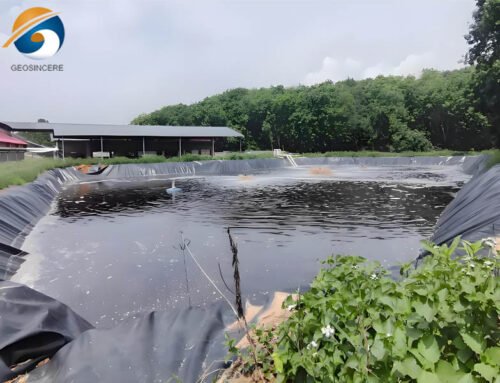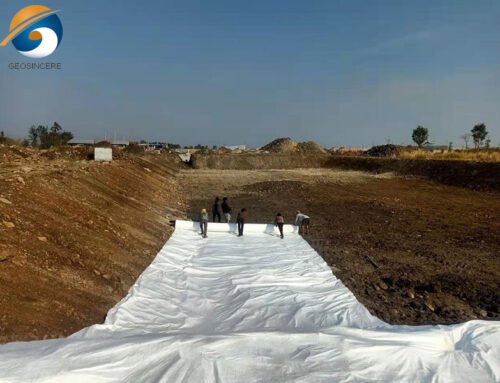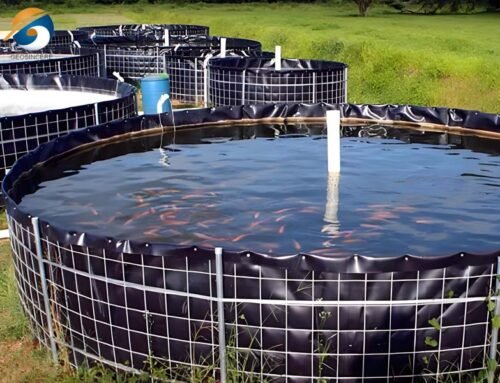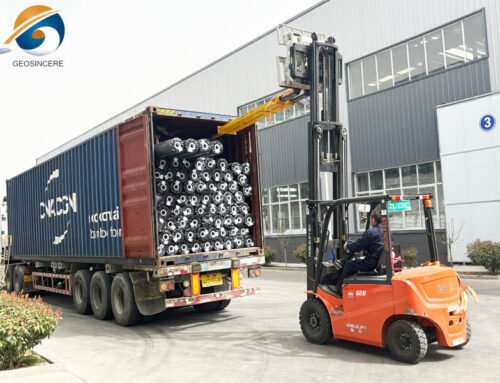Geotextile 100g/m² refers to a type of geotextile fabric with a weight of 100 grams per square meter. Geotextiles are permeable fabrics made from synthetic materials like polypropylene or polyester. They are widely used in civil engineering, construction, and environmental applications due to their durability, strength, and filtration properties.
You’ve likely seen 100g/m² geotextile fabric while you’ve been out and about, or maybe you’ve even used it at some point on your property. The permeable material can be non woven or woven, each type getting used for a variety of applications. For example, non woven geotextile fabric is used for things like retaining walls and sandbags, while woven geotextile fabric is ideal for driveway construction and erosion control projects. However, uses for woven and nonwoven geotextile can vary depending on various project scopes. Both are typically known for perks such as offering soil stability and drainage.
1. Key Features of 100g/m² Geotextile:
Lightweight: Suitable for applications where heavy materials are not required.
Permeability: Allows water to pass through while retaining soil particles.
Strength: Provides adequate tensile strength for stabilization and reinforcement.
UV Resistance: Often treated to resist degradation from sunlight.
Chemical Resistance: Resistant to most chemicals found in soil.


2. Applications of 100g/m² Geotextile:
2.1 Geotextile 100g/m² – Erosion Control:
– Used on slopes, riverbanks, and shorelines to prevent soil erosion.
– Stabilizes soil while allowing vegetation to grow through.
2.2 Geotextile 100g/m² – Drainage Systems:
– Acts as a filter in drainage systems to prevent soil from clogging pipes or gravel layers.
– Commonly used in French drains, retaining walls, and road construction.
2.3 Geotextile 100g/m² – Soil Stabilization:
– Provides a stable base for roads, parking lots, and other structures by preventing soil mixing and improving load distribution.
2.4 Geotextile 100g/m² – Landscaping:
– Used as a weed barrier in gardens and landscapes.
– Separates soil layers while allowing water and nutrients to pass through.
2.5 Geotextile 100g/m² – Agriculture:
– Protects crops by controlling weeds and retaining moisture in the soil.
– Used in greenhouse flooring and as a ground cover.
2.6 Geotextile 100g/m² – Road Construction:
– Separates soil layers in roadbeds to prevent mixing and improve stability.
– Enhances the lifespan of roads by reducing rutting and cracking.
2.7 Geotextile 100g/m² – Pond and Reservoir Liners:
– Protects liners from punctures and provides filtration in water containment systems.
2.8 Geotextile 100g/m² – Temporary Works:
– Used in temporary construction sites for soil stabilization and erosion control.
3. Advantages of Using 100g/m² Geotextile:
– Cost-effective for lightweight applications.
– Easy to handle and install.
– Environmentally friendly, as it reduces the need for heavy machinery and natural materials.
This type of geotextile is ideal for projects where moderate strength and filtration are required without the need for heavy-duty materials.
4. Application Areas For 100g/m² Geotextile:
(1) As reinforcement in retaining wall backfill, or for anchoring retaining wall panels. Construction of wrapped retaining walls or bridge abutments.
(2) Reinforcement of flexible pavement, repair of cracks on the road, and prevention of crack reflection on the pavement.
(3) Increase the stability of gravel slopes and reinforced soil, prevent soil erosion and freezing damage of soil at low temperatures.
(4) Isolation layer between road ballast and roadbed, or between roadbed and soft foundation.
(5) Isolation layer between artificial fill, rock pile or material yard and foundation, isolation between different frozen soil layers, anti-filtration and reinforcement.
(6) Filter layer of the initial upstream dam surface of ash storage dam or tailings dam, and filter layer of drainage system in retaining wall backfill.
(7) Filter layer around drainage pipes or gravel drainage ditch.
(8) Filter layer of wells, pressure relief wells or inclined pressure pipes in water conservancy projects.
(9) Geotextile isolation layer between the foundation and the ballast and artificial rockfill of roads, airports, railways, etc.
(10) Vertical or horizontal drainage inside earth dams, buried in the soil to dissipate the pore water pressure.
(11) Drainage behind the anti-seepage geomembrane or under the concrete face in earth dams or earth embankments.
(12) Eliminate seepage around tunnels, reduce the external water pressure on the lining and seepage around various buildings.
(13) Drainage of artificial fill foundations and sports fields.
(14) Used to strengthen weak foundations in projects such as roads (including temporary roads), railways, embankments, earth-rock dams, airports, and sports fields.


5. How To Choose Geotextile 100g/m² Correctly?
Choosing the correct geotextile, especially for industrial projects, requires careful consideration of several factors to ensure optimal performance and longevity. Here’s a step-by-step guide to help you select the right geotextile with a weight of 100 g/m², specifically focusing on GEOSINCERE products:
5.1 Understand the Application
- Filtration: If the geotextile is needed for filtration purposes, ensure it has the appropriate permeability to allow water to pass while retaining soil particles.
- Separation: For separation applications, the geotextile should prevent the mixing of different soil layers while allowing water to flow through.
- Reinforcement: If the geotextile is to be used for reinforcement, it should have high tensile strength to stabilize the soil.
- Drainage: For drainage applications, the geotextile should facilitate the flow of water away from the area.
5.2 Material Type
- Woven Geotextiles: Typically made from polypropylene or polyester, woven geotextiles are strong and ideal for reinforcement and stabilization.
- Non-Woven Geotextiles: Usually made from polyester or polypropylene, non-woven geotextiles are better for filtration, separation, and drainage due to their higher permeability.
5.3 Physical Properties
- Weight: A 100 g/m² geotextile is generally suitable for light to medium-duty applications. Ensure this weight meets the specific requirements of your project.
- Thickness: Check the thickness to ensure it provides the necessary separation or filtration.
- Tensile Strength: Verify that the tensile strength is adequate for the load and stress it will encounter.
- Elongation: Consider the elongation at break to ensure the geotextile can stretch without tearing under load.
5.4 Hydraulic Properties
- Permeability: Ensure the geotextile has the right permeability (water flow rate) for your application.
- Porosity: Check the porosity to ensure it allows for adequate water flow while retaining soil particles.
5.5 Durability and Chemical Resistance
- UV Resistance: If the geotextile will be exposed to sunlight, ensure it has UV resistance to prevent degradation.
- Chemical Resistance: Verify that the geotextile can withstand exposure to chemicals present in the soil or environment.
5.6 Certifications and Standards
- Ensure the geotextile meets relevant industry standards and certifications, such as ISO, ASTM, or other local standards.
5.7 Supplier Reputation
- Choose a reputable supplier like GEOSINCERE, known for quality and reliability. Check for customer reviews, past project references, and technical support.
5.8 Cost and Availability
- Compare costs from different suppliers but ensure that cost considerations do not compromise quality. Ensure the product is readily available to avoid project delays.
5.9 Installation Considerations
- Consider the ease of installation and whether the geotextile can be easily cut, shaped, and secured in place.
5.10 Consultation with Experts
- If in doubt, consult with geotechnical engineers or specialists who can provide tailored advice based on the specific requirements of your project.
6. Summary
There are several applications where 100 g/m² geotextiles can be applied. As stated, you should ensure that you are using suitable material for your project. When you correctly specify and install 100 g/m² geotextiles, they extend your project’s life, reduce the long-term maintenance costs, and deliver improved performance. Listed below are some applications for 100 g/m² geotextiles:
- Conservancy project : Riverbanks; Dams protection; Diversion irrigation; Reservoir seepage and consolidation project; Filling sandbags.
- Road Project: Soft foundation treatment; Slope protection; Road surface antireflection structure layer; Drainage system; Greenbelt.
- Railway project: railway foundation reinforcement; Embankment slope strengthen layer Tunnel lining layer.
7. Choose A Reliable Supplier To Quote Price For You :
GEOSINCERE has been keeping on investing in technological innovation, manufacturing facilities improvement and turnkey engineering abilities. We have invested 10 million dollars into our manufacturing factory which is equipped with state-of-the-art automatic production lines to manufacture high quality 100g/m2 geotextile and other geosynthetics with optimized processes. Our extensive lines of geosynthetics products are well known for their ensured quality, high performance, excellent durability and best cost effectiveness.
GEOSINCERE brand 100g/m2 geotextile and other geosynthetics products and solutions can meet your requirements by our solid technologies, innovative engineering solutions and excellent customer services. GEOSINCERE always tries our best to solve the most complex civil, mining and environmental challenges with our innovative and high performance geosynthetic products. Quality assurance, factory price and fast delivery time are our competitive advantages.





